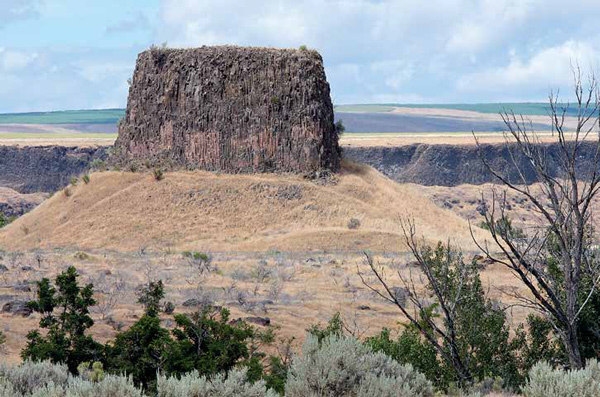Across the Columbia River from Yellepit’s village, the captains hold an impromptu council with the chief and two other Walla Walla men. After passing Hat Rock in the Wallula Gap, Clark frightens several Umatillas who—after seeing Sacagawea—learn he is not part of a war party. The day ends with mutual smoking and fiddle music.
The Umatilla Indians
by Yellowstone Public Radio[1]Originally aired weekdays by Yellowstone Public Radio during the Bicentennial observance of 2003-2006. Narrated by Hal Hansen. Scripts by Whit Hansen and Ed Jacobson. Produced by Leni Holliman. © … Continue reading
Walla Walla Council
The great chief Yel-lep-pet two other chiefs, and a Chief of Band below presented themselves to us verry early this morning. we Smoked with them, enformed them as we had all others above as well as we Could by Signs of our friendly intentions towards our red children Perticular those who opened their ears to our Councils. we gave a Medal, a Handkercheif & a string of Wompom to Yelleppit and a String of wompom to each of the others.
—William Clark
Clark’s Mountain View
I assended a high clift about 200 feet above the water from the top of which is a leavel plain extending up the river and off for a great extent, at this place the Countrey becoms low on each Side of the river, and affords a pros[pect?] of the river and countrey below for great extent both to the right and left; from this place I descovered a high mountain of emence hight covered with Snow, this must be one of the mountains laid down by Vancouver, as Seen from the mouth of the Columbia River
—William Clark
Hat Rock
S W. 14 miles to a rock in a Lard. resembling that a hat just below a rapid at the lower Point of an Island in the Midl: of the river
—William Clark
Umatilla Maiden (c. 1910)
Edward S. Curtis (1868–1952)
Retrieved from the Library of Congress, www.loc.gov/item/94507923, accessed 14 July 2019.
Frightened Umatilla Indians
found the [Umatillas] Indians much fritened, all got in to their lodges and I went in found Some hanging down their heads, Some Crying and others in great agitation, I took all by the hand, and distributed a few Small articles which I chanced to have in my Pockets and Smoked with them which expelled their fears . . . . I am confident that I could have tomahawked every Indian here.
—William Clark
Sacagawea Pacifies the Umatilla
as Soon as they Saw the Squar wife [Sacagawea] of the interperters [Toussaint Charbonneau] they pointed to her and informed those who continued yet in the Same position I first found them, they imediately all came out and appeared to assume new life, the sight of This Indian woman, wife to one of our interprs. confirmed those people of our friendly intentions, as no woman ever accompanies a war party of Indians in this quarter—
—William Clark
Evening Celebration
Indians Came from the different Lodges, and a number of them brought wood which they gave us, we Smoked with all of them, and two of our Party Peter Crusat [Pierre Cruzatte] & Gibson played on the violin which delighted them greatly
—William Clark
Weather Diary
Day of the month Wind State of the Weather 19th S E fair Note from the 18th to the 22d of octr. descending the Great Columbia to the falls [Celilo Falls].
—William Clark[2]Some abbreviations have been spelled out.
Experience the Lewis and Clark Trail
The Lewis and Clark Trail Experience—our sister site at lewisandclark.travel—connects the world to people and places on the Lewis and Clark Trail.
Plan a trip related to October 19, 1805:

Hat Rock is a High Potential Historic Site along the Lewis and Clark National Historic Trail managed by the U.S. National Park Service. The rock can be visited at Hat Rock State Park, Oregon.
Notes
| ↑1 | Originally aired weekdays by Yellowstone Public Radio during the Bicentennial observance of 2003-2006. Narrated by Hal Hansen. Scripts by Whit Hansen and Ed Jacobson. Produced by Leni Holliman. © 2003 by Yellowstone Public Radio. |
|---|---|
| ↑2 | Some abbreviations have been spelled out. |




